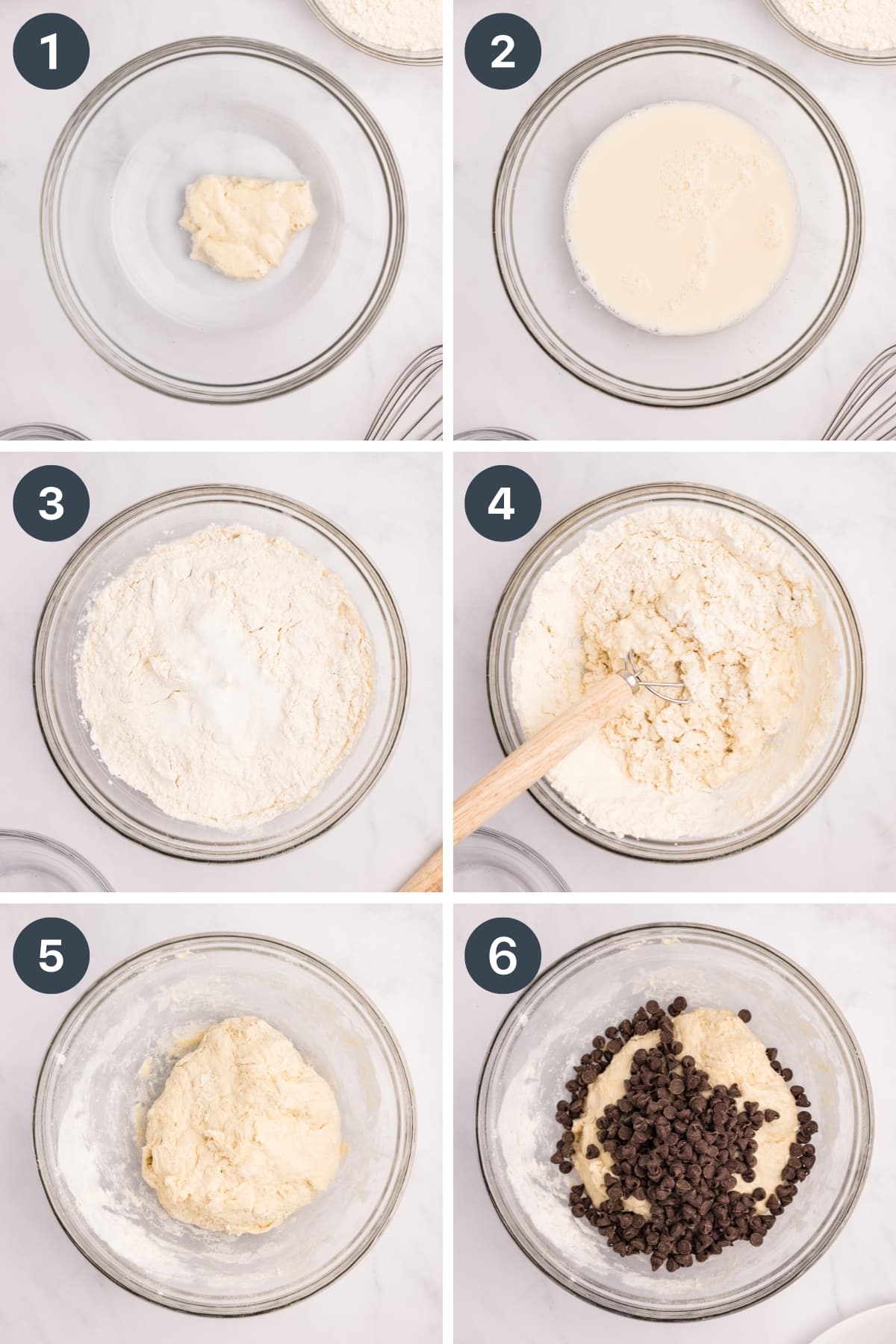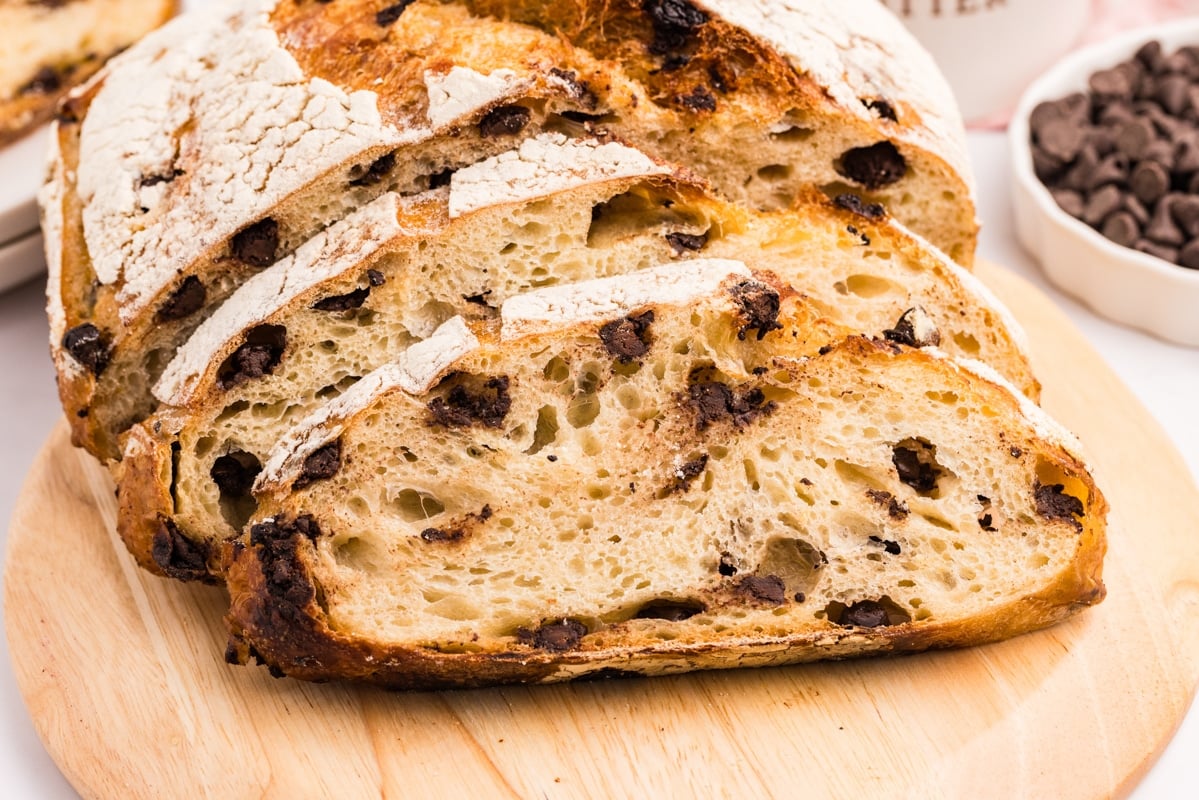This easy recipe for Chocolate Chip Sourdough Bread is a fun twist on the original! Made with just 4 simple ingredients, this beginner-friendly recipe is a play on sweet and savory. The bread dough is unsweetened, while the chocolate chips provide a pop of decadence.
Try it toasted and slathered with butter - you'll be head over heels!

Not that long ago I shared my tried-and-true recipe for sourdough bread. I figured it was high time I started sharing some of the yummy variations I've dreamed up in the kitchen over the years.
The first one is my personal favorite: chocolate chip sourdough bread.
This recipe holds a special place in my heart, as the addition of chocolate chips was my first foray into anything outside of your typical boule when I first started my sourdough journey many years ago.
Although simple, it's incredibly delicious, easy to make, and absolutely amazing when toasted and slathered with butter. It's one of my son's absolute favorites!
Why You'll Love It:
- Easy. This recipe uses my beginner-friendly Dutch Oven Sourdough Bread as a base.
- No lamination needed. Since I wanted to keep this recipe simple, I've skipped over complicated lamination steps, and instead you will incorporate the chocolate chips during the stretch-and-folds.
- Just 4 ingredients. Other than water, all you'll need is flour, salt, sourdough starter, and chocolate chips.
- Sweet...but not too sweet. This is a basic sourdough boule with no added sugar to the base. It's a little sweet - but not so sweet I would call it a dessert. Think of it like chocolate chip bagel bread.
You Will Need:

- Sourdough starter: You need a mature, active sourdough starter that is at least 2 weeks old. If you have a refrigerated starter, you'll get the best results from ensuring it has been fed 2-3 times before you attempt to bake bread. If you don't have one yet, check out my guide on how to make your own sourdough starter.
- Flour: I strongly recommend using bread flour for this recipe. I don't know what it is, but it makes the chocolate chips really shine (and yes, I've tested it both ways!). If you can't find bread flour, you can always make your own bread flour with all purpose and gluten flour.
- Salt: Any fine salt works for this recipe! I like to use fine sea salt OR Redmond's Real Salt - the choice is yours. Just avoid large crystals like kosher or Maldon.
- Chocolate chips: I use regular ol' semi-sweet chocolate chips, but you can use whatever you like best! There are options for dairy free, stevia-sweetened, etc.
- Water: You will want water that is a little warmer than room temperature, but avoid "hot" water. This is both to avoid over proofing and the melting of the chocolate chips. If you're on municipal water that has chlorine or other additives, use filtered water.
Equipment and Tools:
- Dutch oven (or bread baking cloche)
- Parchment paper (or silicone sling)
- Bread lame (razor blade, or sharp knife)
- Digital scale (recommended)
- Proofing basket (or large bowl)
- Dough whisk (optional, but a great tool for sourdough bakers!)
How to Make Sourdough Chocolate Chip Bread
Making the Dough

- Add 300 grams (1 ¼ cups) of water and 100 grams of active sourdough starter to a large bowl.
- Whisk well to combine.
- Add the flour (500 grams) and salt (10 grams) to the bowl.
- Stir the flour in until well incorporated (I like to use a dough whisk) and it forms a cohesive ball. You will need to use your hands towards the end to bring it together and get all of the odd bits together (I recommend running some water over them first to reduce sticking).
- Rest the dough. Cover the bowl with plastic wrap or a damp kitchen towel and allow to rest for 30 minutes.
- Add the chocolate chips. Once the dough has rested, it's time to add the chocolate chips (1 cup) and get started on the stretch-and-folds!
The Stretch-and-Folds

- Using wet hands (to prevent sticking), pick up one side of the dough, stretching it as far as you can, and folding it back into the middle. Repeat in a clockwise motion, 4-6 times, picking up another section of dough, stretching it, and folding it. This process will gradually incorporate the chocolate chips.
- Once complete, cover the bowl and let the dough rest for 30 minutes.
- Repeat the series of stretch and folds. Notice how to dough begins to build strength; you should be able to pull the dough a little further each time without tearing.
- Cover the bowl and allow to rest for another 30 minutes.
- Repeat the stretch-and folds, then cover and rest for 30 minutes. If desired, repeat one more time (a total of 3-4 sessions is the goal).
- Once your final set has been completed, you're ready for the bulk rise (also known as the bulk ferment).
The Bulk Fermentation
Cover the bowl tightly and allow to rise at room temperature for about 8-12 hours, or until the dough has roughly doubled in size.
If your home is cooler, you may need to place the bowl in a slightly warmer spot like the top of your refrigerator or in the oven (turned off) with or without the light turned on (sometimes the light can cause the oven to become a little too warm - so adjust accordingly).
Shaping and Baking the Loaf

- Once the dough is proofed (it should nearly double in size), you're ready to shape the loaf. For most, this will be the next day (if the bulk rise was done overnight).
- Turn the dough out onto a lightly floured work surface, and flatten it slightly with the palm of your hand. Then, roll it up, pinching in the sides to form a round shape (or an oval if desired).
- Prepare a proofing basket by dusting it with flour (rice flour works best, but all-purpose will do just fine). Place the round dough, smooth side down (and seam side up), into the prepared proofing basket.
- Final proof. Cover the basket tightly (I like to wrap it with plastic, secure with a large rubber band, then place it inside of a plastic bag). Place the basket in the refrigerator to cold proof for 8 hours (see below for notes on skipping the cold proof). Once the time is up, remove the boule from the the fridge and allow it to come to room temperature (this takes about 2 hours).
- Preparing for Baking. Preheat the Dutch oven in a 450ºF (232ºC) oven for 45 minutes (while your bread comes to room temperature). Once the dough is ready and the dutch oven is preheated, place the dough in a silicone sling (or on a piece of parchment paper) and score the top of the dough with a bread lame (sharp knife, or razor). I recommend doing 2 cuts - one in the middle, and one on the left side (curved).
- Bake the loaf. Immediately place the scored bread in the preheated Dutch oven and bake (with the lid on) for 25 minutes.
- After the 25 minutes are up, remove the lid and reduce the heat to 375ºF (190ºC). Bake for another 25-30 minutes.
- Remove the bread from the oven and allow to cool for AT LEAST 30 minutes before slicing, but 2+ hours is ideal for the best texture.
Without a Proofing Basket
If you don't have a proofing basket (AKA banneton basket) - no worries! There are some budget-friendly alternatives.
- A large bowl lined with parchment paper (crumple it first so it's not so rigid)
- A Dutch oven lined with parchment (again, crumpled)
- A decorative basket lined with plastic or parchment
Can I Skip Cold Proofing?
I've tested this recipe with and without the cold proofing step (placing the banneton basket in the fridge for 8 hours). While cold proofing gave the best oven spring and texture, the alternative really wasn't bad!
- Shape the dough, place it in the basket and cover it well.
- Allow to proof at room temperature for 1-2 hours, or until puffy.
- Bake as directed in a preheated Dutch oven.

Storing your Sourdough Loaf
- First, let the loaf cool to room temperature.
- Tightly wrap with several layers of plastic wrap (or place in a linen bread bag)
- Keeps well at room temperature for up to 3 days (if wrapped in plastic, 1 day if in a bread bag).
- Can be kept in the refrigerator for up to 4 days, but the bread will become a little more dense or tough.
- To freeze, slice, then wrap tightly with plastic wrap. Place the wrapped loaf in a freezer bag and label. Remove slices as needed.
- Leftover sourdough bread that is too hard for toast can be used to make sourdough croutons, breakfast casserole, bread pudding, or breadcrumbs.
How do I know if my starter is ready for making bread?
- It has lots of bubbles
- Has doubled in size after the most recent feeding
- Signs of activity and movement
- Passes a float test (not foolproof, but can be helpful)
- At least 1 week old, but 2+ weeks is preferred
- Has been fed at least 2-3 times after refrigeration (if you keep your starter in the fridge)
- Smells pleasant and yeasty

Variations
Double chocolate: Add some cocoa powder to the bread dough in addition to the chocolate chips.
Dark chocolate: Use your favorite dark chocolate chips (or a chopped dark chocolate bar) in place of the semi-sweet ones used in the recipe.
White chocolate: Add 1 cup of white chocolate chips to the dough. If desired, add some dried cranberries for a yummy cranberry white chocolate sourdough bread.
Chocolate chunks: Use chocolate chunks (or even mini chocolate chips) instead.
Recipe FAQs
If you don't have a Dutch oven for baking sourdough bread, there are a few other options. The main ones are of course a bread cloche OR a clay baker with a lid, but most home bakers do not have those. Instead you could use a roasting pan with a lid, or even a baking stone (or sheet) with a pan of hot water beneath to keep the moisture level high.
Even experienced bakers have the occasional loaf of bread that is over proofed and does not rise properly in the oven. It doesn't need to go to waste. Instead, slice the loaf and use it to make sourdough croutons, bread pudding, breakfast casserole, or even breadcrumbs.
Next time, keep an eye on your loaf during the bulk rise. It may not need as long for proofing as stated in the recipe if your house is very warm, or your starter is very active. Watch for it to nearly double; if it seems to be proofing quickly, you can place the bowl of dough in the fridge to slow the fermentation down until you're ready to shape.
While bread flour does tend to make the best sourdough bread, it isn't necessary. Instead, you can use all purpose flour, or make your own bread flour by combining all-purpose and gluten flour (also known as vital wheat gluten). Gluten flour can be found online or at bulk food stores.

Sample Baker's Schedule
This is just an example meant to give you an idea of how to plan your baking. It shouldn't be any trouble to customize it according to your schedule. You can lengthen the cold proofing stage to account for work, sleep, life, etc (see the note below).
First Day
- 9AM: Feed your sourdough starter with a 1:1:1 or 1:2:2 ratio (former for a cool home, later for a warm home).
- 1-5PM: Your sourdough starter should be at its peak - which is roughly double the original size.
- 1-5PM: Prepare the first proof by combining the water and starter, then stirring in the flour and salt. Allow the dough to rest for 30 minutes.
- 5:30PM: Add the chocolate chips and complete your first set of stretch-and-folds.
- 6:00PM: Complete your second set of stretch-and-folds
- 6:30PM: Complete your third set of stretch-and-folds
- 7PM (optional): Complete your fourth set of stretch-and-folds.
- 7:00PM: Cover the bowl tightly and allow to rise at room temperature for 8-12 hours, or until doubled.
Second Day
- ~7:00AM: Shape the bread and place it into a prepared proofing basket.
- 7:00AM: Cover the bread and place it in the refrigerator to cold ferment for 8 hours.
- 3:00PM: Remove the bread from the refrigerator and allow to come to room temperature (about 2 hours)
- 5:00PM: Bake the bread as directed in the recipe.
- ~6:15 PM: Fresh bread is ready to serve!
Note: Depending on how quickly your starter rises, this schedule can shift by several hours. If you need to extend the proofing time in order to make bread around your sleep or work schedule, the best way to do that is during the cold proofing stage.
Your shaped loaf can proof in the refrigerator for anywhere from 8-48 hours, so you can give yourself a lot of wiggle room once the bread is in the refrigerator.

More Favorite Sourdough Recipes:
If you loved this recipe for Chocolate Chip Sourdough Bread, let me know by leaving a 5-star review in the recipe card or comment below! You can also tag me on Instagram @littlehomeinthemaking.
📖 Recipe

Chocolate Chip Sourdough Bread
Equipment
- Dutch oven (Or large roasting pan with a lid)
Ingredients
- 100 grams active sourdough starter* about 1 cup
- 300 grams warm water** about 1 ¼ cup
- 500 grams bread flour*** about 4 cups
- 10 grams salt about 1 ¾ teaspoons
- 1 cup chocolate chips (150-170g)
- 3-4 ice cubes
Instructions
Forming the Dough
- Add the water to a large mixing bowl, along with the active sourdough starter. Whisk the water and starter together until “milky”.
- Add the salt and all-purpose flour to the bowl and stir together until a shaggy dough forms. I like to use a Danish dough whisk for this, but you can use a regular wooden spoon, then bring it together with your hands as the dough becomes increasingly sticky.
- Once everything is mixed together, cover the bowl with a damp towel or plastic wrap. Allow to rest for 30 minutes.
Stretch and Folds
- After the 30 minutes have passed it’s time to start the stretch and folds. This helps to build dough strength without kneading.
- Before you start, add in 1 cup of chocolate chips. These are folded into the dough during the process.
- Remove the covering from the bowl. Wet your hands with some water (this prevents the dough from sticking to your hands), then pick up one corner of the dough, and stretch it up and over so it folds over the dough. Repeat this process 4-6 times in a clockwise motion, turning the bowl, picking up a section, and folding it over.
- Once you’ve finished the stretch and folds, cover the bowl tightly and allow it to rest for another 30 minutes.
- Repeat the stretch and fold process 2-3 times (for a total of 3-4 sessions).
- Note: Each stretch and fold session you will notice the dough becoming stronger and you’ll be able to pull the dough further. The gluten is being developed through this process. You will know the dough is ready for its bulk rise when the dough is soft, smooth, and pliable. If your dough shows signs of strength and is very difficult to stretch after 2-3 sessions, you can skip any remaining sessions as your dough is ready for the bulk ferment.
Bulk rise
- Once the final stretch-and-folds are complete, cover the bowl and allow it to rise for about 8-12 hours, or until the dough has almost doubled in size. This is the bulk rise (also known as the bulk ferment).
- After the dough has roughly doubled in size, prepare a proofing basket (AKA banneton) by generously flouring the basket. You can use all-purpose flour or rice flour for this step. If you don’t have a proofing basket, you can use a large bowl lined with crumpled parchment paper. Set the prepared basket aside.
- Turn the dough out onto a lightly floured surface.
- Flatten out the dough and roll the dough up while folding in the sides until it resembles a round or oval shape (depending on the shape of your banneton or proofing basket).
- Place the dough (smooth side down) into your proofing basket. Cover and place it in the fridge for 8 hours (or for up to 48 hours). This is known as cold proofing, and helps to give the bread better oven-spring.
Final Proofing and Baking
- At the 8-hour mark, remove the dough from the fridge and allow it to come to room temperature (this will take about 2 hours).
- Prepare your oven by removing all but 1 rack from the oven. Place the remaining oven rack in the bottom groove.
- Place your Dutch oven in the oven on the bottom rack.
- About 45 minutes before your dough is ready to bake (1 hour 15 minutes after pulling it from the fridge), preheat the oven to 450ºF (232ºC) with your Dutch oven inside the oven (preheating the baking vessel gives the finished bread better oven-spring).
- Approximately 10 minutes before you’re ready to bake, turn the dough out onto a silicone bread mat or a piece of parchment paper.
- Using a bread lame, razor, or sharp knife, make a cut (slash) in the middle of the boule, and one curved cut on the left side. This is called scoring the dough, and it helps control the shape of the bread and allows it to rise evenly during baking.
- Place the dough into the Dutch oven, then add 3-4 ice cubes around the perimeter, and cover with a lid. This will create steam and moisture, helping the dough to rise and create a slightly softer crust (compared to baking without steam).
- Bake at 450ºF (232ºC) for 25 minutes with the lid on.
- After 25 minutes, remove the lid, reduce the heat to 375ºF (190ºC), and bake for an additional 25-30 minutes, or until the bread reaches an internal temperature of 200-205ºF (93-96ºC).
- Carefully remove the bread from the Dutch oven and place it on a cooling rack. Allow to cool for at least 30 minutes before slicing and serving.
Notes
- Use a digital scale if available - you’ll get the best and most consistent results.
- Cold or hot weather can affect the rise time. You will notice faster proofing times when it is warm, and slower ones when your home is cool.
- Ensure your starter is active; you should see lots of bubbles and activity. Use it once it has reached its peak, which is when it has roughly doubled in size.
Nutrition
Please note that some of my blog posts here at Little Home in the Making may contain affiliate links. If you make a purchase through these links, I will get a small commission at no additional cost to you. See our disclaimer for more information.
























Trisha Lynn Appeldorn
Can I ask what you mean to put ice cubes on the "perimeter" inside the dutch oven?
Dolly | Little Home in the Making
Hi Trisha, I mean to place them around the edge, under the parchment if possible. This creates some steam for the bread, which helps it bake up with a bit softer of a crust.